Dr. R.N. Sreenivas Gowda*
Introduction
The Poultry sector is a most important segment of the livestock industry. This sector consists of many different levels of production, including breeding farms, hatcheries, feed factories, , broiler and layer farms and proczessing plants. Likewise, there are sub-units such as chicken, quail, duck, turkey, guinea fowl and goose in terms of species in the sector. In terms of infrastructure, different types of housing from thatched shed to automated, environmentally controlled sheds, normal feeders to automatic feeders and regular channel watering systems to automatic cups and nipples, automatic egg collection, refrigeration systems, nutraceutical and medicine manufacturing units, vaccine manufacturing units, manufacturing mechanical components to electronic gadgets required for various functions. Rendering plants and production for feathers. Therefore, it involves all the derived sciences such as physics, chemistry, biology, biotechnology, and other engineering skills. There is enormous growth and progress in this sector and the sub-classes for production are divided into meat and egg production. All these have gradually grown from back yard to industrial proportion over six decades (1960 to 2020) owes to veterinarians, poultry scientists, technical and non- technical persons and dedicated farmers.
With all the developments yet there is organized and unorganized sectors in poultry in our country. Organised sub-sector needs conducive environment to grow for which policy support & intervention is required mainly for disease surveillance, drug residue and drug/ vaccine quality control, standardization & quality control of poultry feed, eggs & meat, application of HACCP (Hazard Analysis and Critical Control Point) and Good Manufacturing Practices (GMP) for compliance to WTO & CODEX norms and gradation, value addition, brand promotion & export boosting etc.
By the end of this decade, globally, poultry meat is expected to represent 41 per cent of all the protein from meat sources, according to the OECD-FAO Agricultural Outlook 2030.
The Indian poultry industry is poised to benefit from the ongoing changes in lifestyles in general and eating habits in particular. No wonder, the share of organised commercial farms is rising as it is largely modernized and technically improvised.
According to government data, egg production has been rising steadily, having risen from 95 billion in 2017-18 to 105 billion the following year and to 114 billion in 2019-20. Similarly, poultry meat production, too, has been expanding. from 3.7 mmt in 2017-18 it grew to 4.1 mmt the following year, and then on to 4.3 mmt in 2019-20.
Although ambitious, some projections suggest, by 2023, the country may produce 136 billion eggs and 6.2 ml t poultry meat.
The global poultry market reached a value of nearly $319.2 billion in 2019, having grown at a compound annual growth rate (CAGR) of 5.5% since 2015, and is expected to grow at a CAGR of 6.1% to nearly $405 billion by 2023. The market is expected to grow at a CAGR of 7.2% to nearly $465.7 billion by 2025, and at a CAGR of 6.8% to $645.7 billion by 2030.
Change in the farming systems
The progress in is all sectors of poultry is due to the advancement of technologies in the management, nutrition and health care systems. Over the years, the successors of farmers now are with highly qualified and having double degrees, Technical / engineering and even medical and veterinary professionals. Therefore, the poultry industry is now in the hands of well leaned and educated groups. They always think differently and adopt any technology available globally for the benefit of profitability. These are not only innovators but also have open mind to accept and adopt any innovation that are useful in modern poultry farming. The new farming systems are called “Smart farms, Automated farms, Mechanized farms and Digital farms.
New Trends in Poultry Farming
Two years ago ( March 11, 2020) the World Health Organization formally declared a pandemic caused by a novel coronavirus. And as COVID-19 spread across the globe, humanity had little time to adapt to lockdowns and staggering losses.
The COVID-19 pandemic has severely affected many economic sectors across the world, including livestock production. It has also sparked fears of an impending economic crisis and recession. Disrupted production and transportation, declining consumer demand and volatile markets brought huge financial difficulties, even leading to the permanent closure of many farms. Social distancing, self-isolation and travel restrictions have led to a reduced workforce across all economic sectors and caused many jobs to be lost. Schools have closed down, and the need for commodities and manufactured products has decreased. In contrast, the need for medical supplies has significantly increased. The food sector is also faced the increased demand due to panic-buying and stockpiling of food products. More than the above, the problems started in labour management and this lead to adopt new innovative ideas in poultry farming. In short 2020 was a critical year- COVID-19 posed numerous challenges for the poultry industry, from worker shortages to interruptions throughout the supply chain. The New technologies can help the industry solve these issues and look forward to future opportunities to thrive and succeed. This paper deals with the adoption of several such advances and innovative products for a successful poultry farming. The following are emerged as some of the new trends in poultry Farming:
- Is there a genetic solution for preventing male chicks?
- 3D cameras could capture precision broiler weights
- MRI technology can help identify which eggs are fertile
- Could smartwatches solve poultry processing’s labor problem?
- 24/7 feedback loops could improve poultry flock outcomes.
- Collaborative robots could further poultry automation
- In-line poultry chilling could be improved using kinematics
- Preventing antibiotic resistance in poultry using peptides
- Digital technologies set to simplify poultry data analysis.
- Hyperspectral imaging could help find poultry meat defects.
- Machine vision can detect broiler floor distribution.
- Will CRISPR transform the poultry industry?.
- Robots are ready to meet poultry processing challenges.
- Automation helps prepare case-ready poultry for the future.
- Digitalization can optimize poultry productivity planning
- Healthy chicks establish adult poultry microbiome quickly.
The Technologies that could disrupt future production and processing operations are:
1. Remote sensing
Remote sensing allows visibility in real-time on a number of factors, conditions within the poultry house, bird performance, bird health and welfare. Not only is it the case that the farmer can keep watch over the status of sheds and birds when they decide to take a look at the computer but importantly the readings from these sensors can be set to provide “alerts” to management if any parameter falls out with the agreed requirements for the specific age of birds 24/7.
- Sensors can help streamline the data collection process for both birds and workers, resulting in precision poultry production.
- Application of the smart phones helping the owner to monitor real time environmental contexts such as temperature, humidity, ammonia gas, water level.
- In this system describes an Integrated Solution for Smart Poultry Monitoring Using WSN (wireless Sensor Network) and GPRS Network.
- For example, in poultry, sensors can be used to help estimate body weights and measure the flock uniformity.
They can also help solve labour issues and improve worker retention and food safety when used as a wearable sensor for employees.
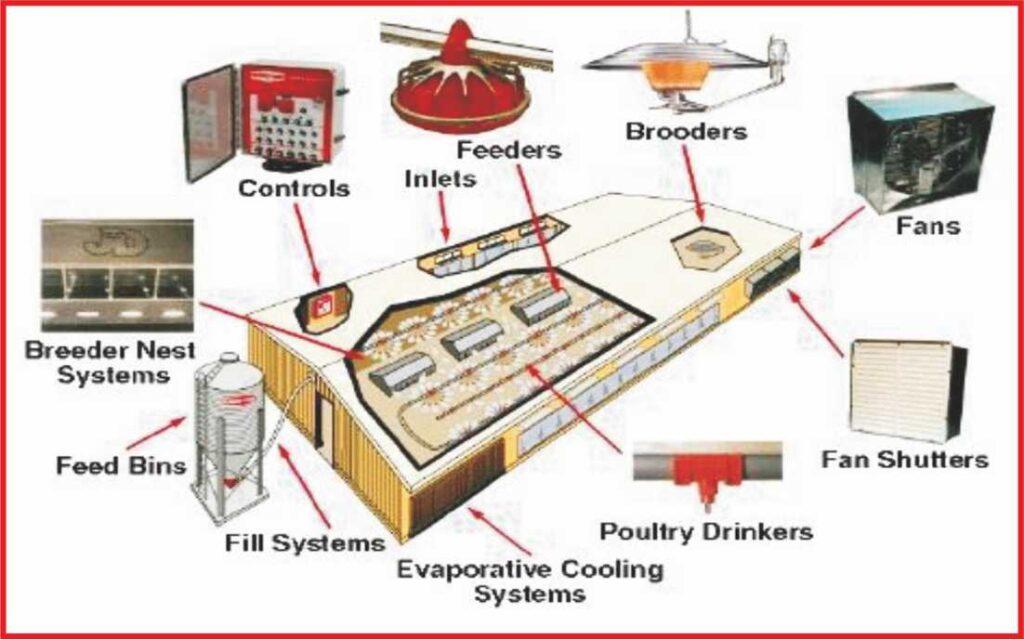
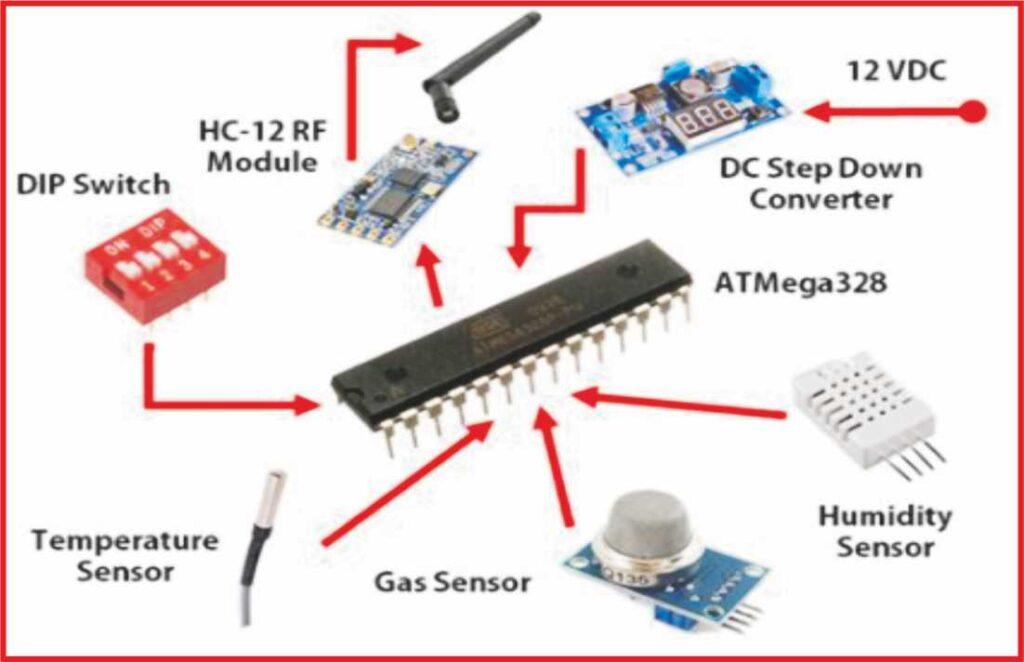
Fig:1.Use of gadgets at different stages of poultry operations
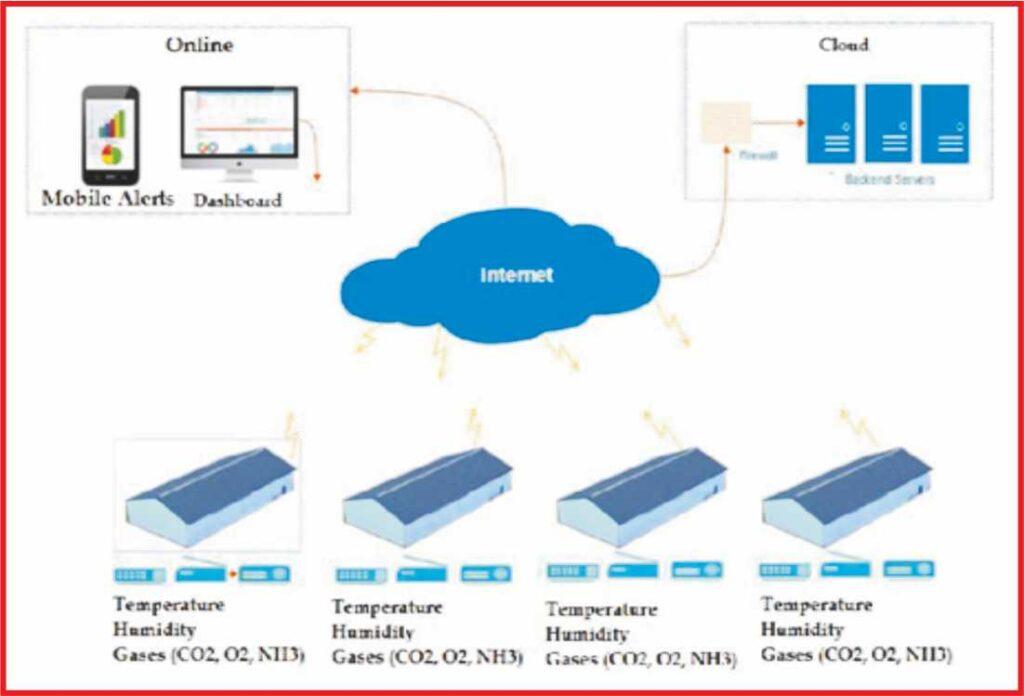
Fig:2. Automation and use of internet to measure the data generated in different houses
1. Automation and Digitalization, Big data: a major value chain in poultry Industry
- Automation can be used to replace manual labor on poultry farms when it comes to repetitive tasks like checking bird welfare, removing welfare, vaccinations and managing litter.
- In processing plants, there are robots that can cut meat from the bones, which could help space out workers at risk of COVID-19.
- The integration of wireless sensors and GPRS network to control and automatically monitor environmental parameters in a poultry farm.
- The environmental parameters like temperature, humidity, ammonia gas control etc.
- The person in-charge can able to get the internal environmental situation of poultry farm by receiving a message on registered mobile number
2. Robotics and automation
Robotics and automation generated intense interest for their potential to reduce labor, be on duty 24/7 and report remotely. Robotic technology can encourage broiler breeders and layer hens to move around the house, reducing the incidence of floor eggs and stimulating fertility, improving bird health and welfare and reducing the amount of labor required. The robot can save up to 50% of a farmer’s time, reduce the number of trips by two-thirds and improve working conditions.
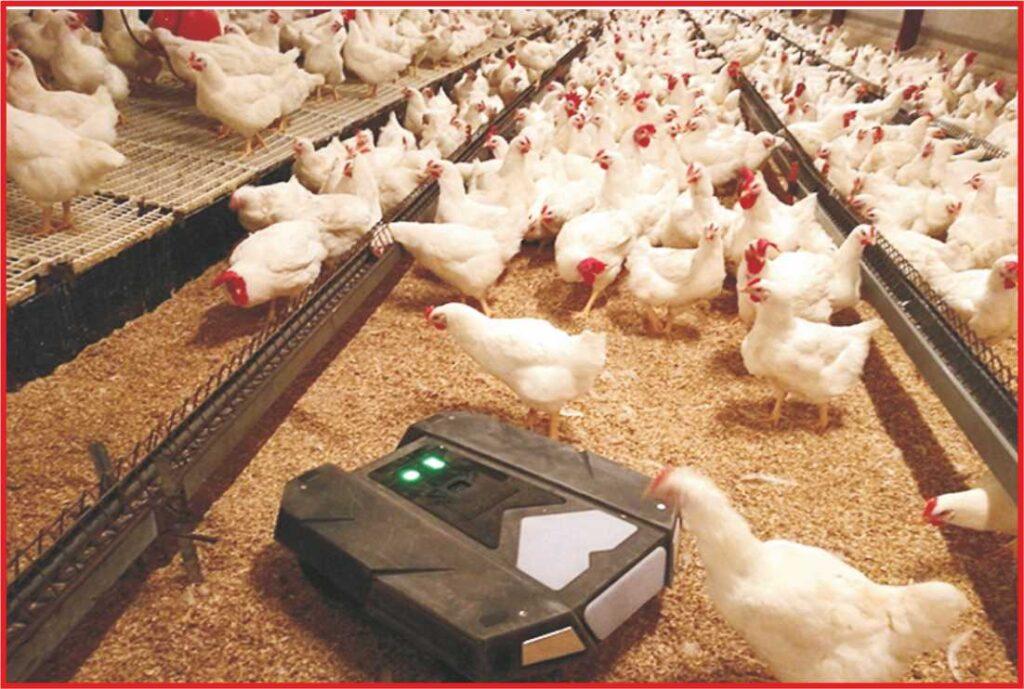
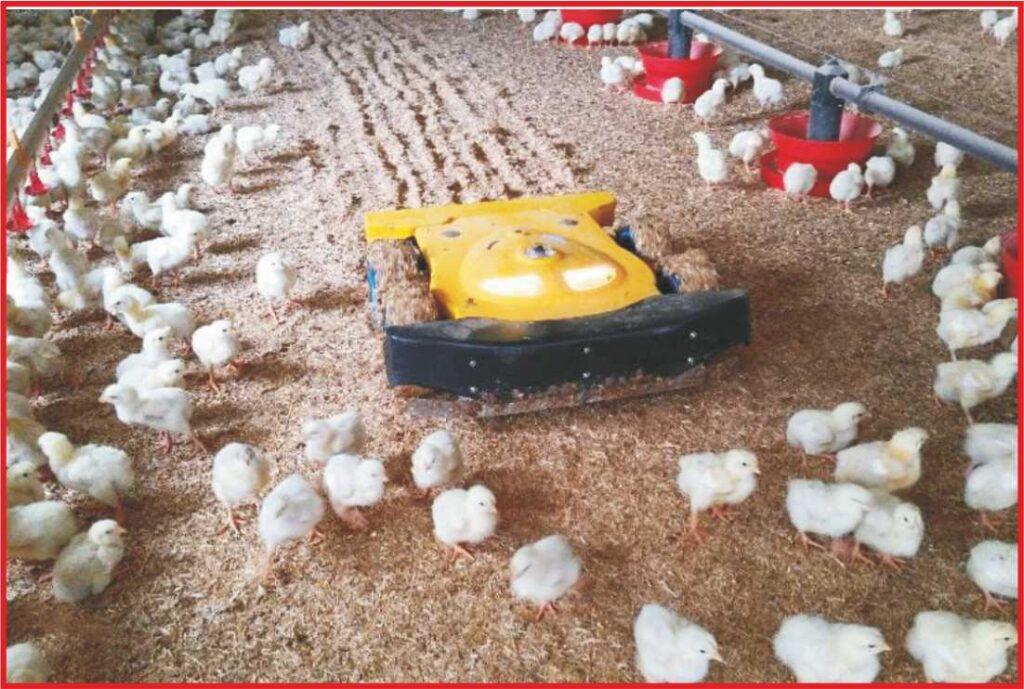
Fig:3. Robots in poultry operation
Robotic technology that uses artificial intelligence to help farmers make data-driven decisions about broiler production could result in a healthier, more productive growing environment. Use robotics to encourage the birds to be more active to increase muscle mass, which ultimately drives better improvements when it comes to the feed conversion ratio.
Robots offer not only increase productivity and profits but their presence can also contribute to improved health and welfare. Some robots will continuously scratch the litter to eliminate caking and wet spots, reducing the incidence of pododermatitis, foot burn and breast burn(fig4). Others can monitor and map ammonia, temperature and humidity levels throughout the house. This is valuable information for producers who can adjust ventilation and address any localized issue that may affect bird welfare or productivity. These corrections can prevent a localized issue from affecting the entire flock.
a). Collaborative robotic technology : is one of the most popular new trends in automation.
Collaborative robots, also known as ‘cobots’ are designed to work safely alongside human workers. Typically, the robot is responsible for any repetitive task, freeing up the human worker to perform more complex, thought-intensive tasks. The robot that navigates poultry house floors using imaging sensors and machine learning, has the capability to detect and pick up floor eggs and sense environmental temperatures, gasses and light levels. Robots can free up human workers to perform more complex, thought-intensive tasks, streamlining operations.
Some of the benefits of Cobots include:
- Cost-effective approach to simpler applications
- Improved ROI calculation for low-speed applications
- Ability to implement robots into space constrained applications
- Shorter programming time
- Quicker deployment
b). Chicken Boy, an autonomous ceiling-suspended robot incorporating artificial intelligence and sensors, assesses ambient conditions, health and welfare and equipment failures. Already on the market in Europe, developers at Farm Robotics and Automation planning to continue adding capabilities including removal of dead birds and analysis of litter moisture.
4. Monitor poultry floor distribution with machine vision
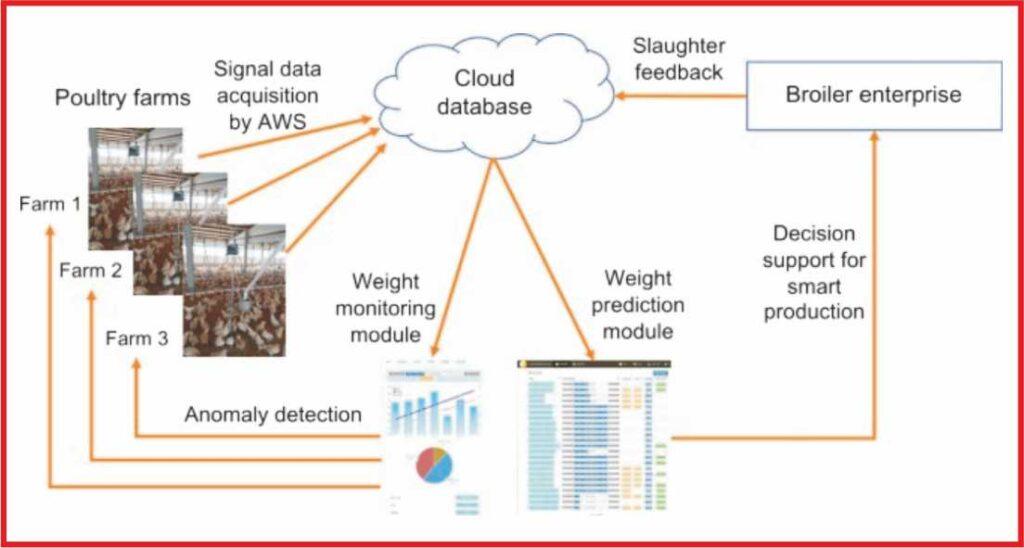
Fig 4: Smart poultry production and data recording for anaysis
In commercial bedding floor poultry houses, bird density and distribution pattern are critical factors for evaluating production management and animal health/welfare. Currently, daily routine inspection of broiler flock distribution in commercial grow-out houses is done manually, which is labor intensive and time consuming. This will also indicate how a machine vision-based method can monitor floor distribution of chickens in drinking, feeding and resting/activity zones. This study provides the basis for developing a real-time evaluation tool to detect broiler chicken floor distribution patterns, behaviors and welfare indicators in commercial production facilities.
The egg sector also has its fair share of applications for AI. The quality of the egg white for instance, the absence of any trace of yolk – is important for many applications requiring optimum egg white foaming. Modern breakers operate at very high speeds, in the order of 200,000 eggs per hour or roughly 60 eggs per second, making it impossible for the human eye to detect an issue.
a). Artificial Vision: In poultry processing the use of artificial vision offers real-time yield monitoring of high-value chicken parts, allowing supervisors to immediately give feedback to employees who can address any potential deficiency. Artificial vision also constitutes a standardized method that can be used to compare results between workers, shifts and processing plants, particularly valuable for large companies operating across multiple sites. Artificial vision can also be combined with smart automation to optimize efficiencies; for example, where broiler parts are automatically sorted after inspection. For processors, AI allows higher processing speeds and accurate packing of premium value products, translating both into more profits and fewer customer complaints. Researchers are now looking at means to totally replace human intervention for some specific tasks considered painful or hard to achieve accurately and consistently.
b). Woody Breast Detection with machine vision and high-speed cameras is capable of detecting and/or sorting breast fillets at normal line speeds without contacting or damaging fillets. Muscle rigidity is measured as the fillets move on and fall off a conveyor.
c). 3D Bird Deboning Cutting Virtual Reality generates cutting trajectories for automated poultry processing systems. It is under development at Georgia Tech Research Institute. Testing started with models but now is on real birds.

Fig: 5. automation in checking o f meat and eggs.
d). Food safety
Food safety is a critical concern in the poultry business, and the innovations. This needs to be addressed both the live production and processing stages. All the above technologies developed ultimately help the production of safe food for human consumption.
5. Technicon Composite-housing Gearboxes
with steel endoskeletons eliminate rust, dissipate heat and withstand wash-down processes. Housings are corrosion-resistant and blended with an antimicrobial material that does not exhibit odor or staining in harsh environments. Market launch is perhaps two years away, and prices of the composite gearboxes are expected to be competitive with units with painted cast-iron housings.
6. Clear Labs Next Generation Sequencing
Using advanced data analytics and bioinformatics tools for detection and serotype identification of Salmonella spp. in samples taken from carcass rinses, ground poultry, poultry parts, boot swabs and equipment swabs. The system’s accuracy reduces inventory holding time and delayed shipments, confirmation costs and delays, and retail short-supply penalties.
7. Big data and artificial intelligence
Harnessing the increasing amounts and complexity of data available to the poultry enterprise is not only a daunting task but a huge opportunity (fig. 6 and 7).
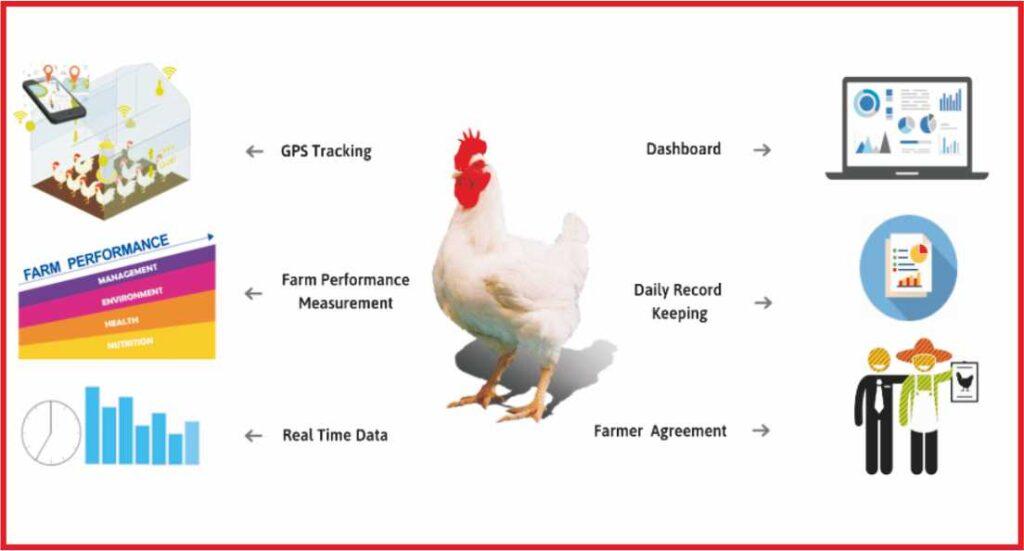
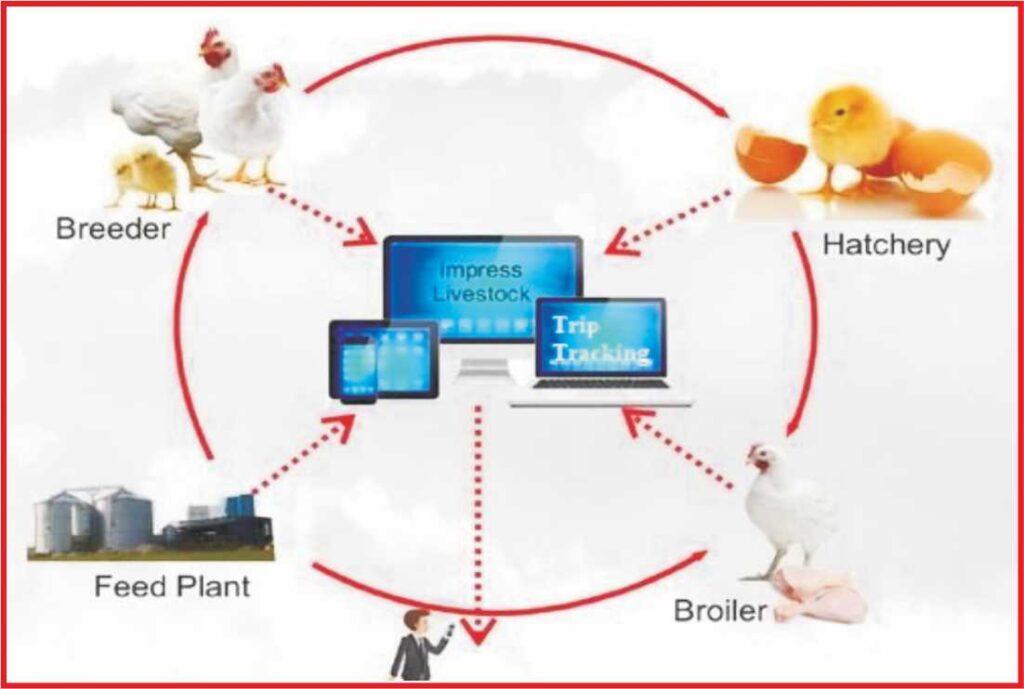
Fig 6. Data generated by breeders, Hatchery, Feed plant and Farms are computerized
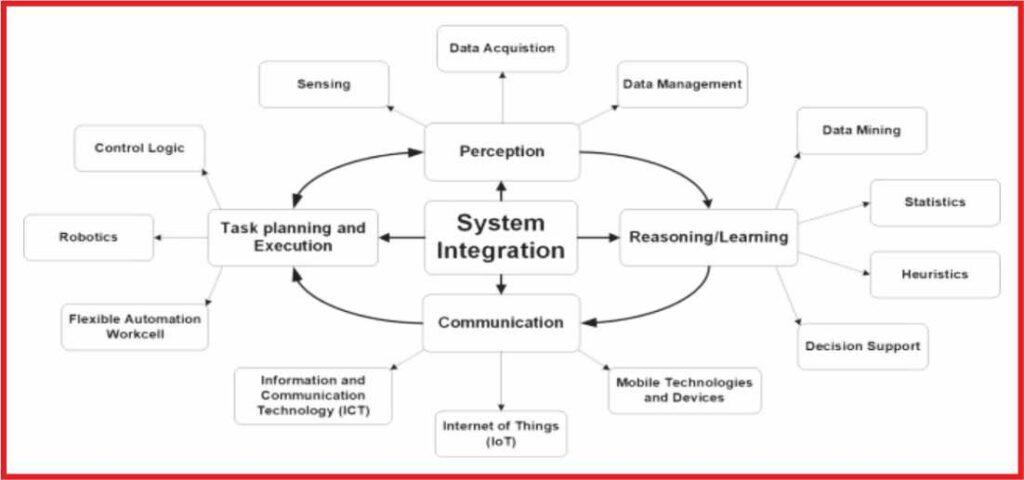
Fig:7. System integration in poultry operations
8. Artificial Intelligence(AI)
Artificial intelligence, when applied to broiler and egg production, may not only improve efficiency but help producers address following challenges.
- Scientists are now teaching machines how to recognize any sound of distress or discomfort to aid in monitoring bird wellbeing.
- Another area with great potential for AI is its use in detecting early stage disease.
- AI has the potential to assist in detecting diseases during their incubation period, allowing producers to quickly prevent spread throughout a flock.
- AI can also help with disease diagnosis.
- Using AI to complement or augment the human brain – collaborative intelligence – will give us the potential to be more efficient and accurate in diagnoses.
- Other areas for AI include feed formulation optimization, genetic selection and hatchery management.
- All segments of the poultry sector will be able to benefit from applications using AI.
- Using advanced artificial intelligence software, integrators can find solutions through data that would otherwise difficult to perceive.
- New artificial intelligence technology can help integrators save money and get better flock performance by facilitating investigation and decision making.
9. Little Bird Feed Cast System
This estimates the amount of feed in on-farm bins using a small device to apply vibration to the bin surface along with sensors and software. The solar-powered units wirelessly report feed levels via web portals and a mobile app to growers, feed mills and integrators. The web portal presents a history of a house’s feed levels and displays projections. Feed outages are reduced or eliminated and less feed is reclaimed at the end of a flock.
10. Poultry System Simulation Model ( PYSSM) :
Simulates the water, energy, wastewater and labor utilization of a poultry processing plant. Based on VENSIM [http://vensim.com/vensim-software/] software, the model simulates all processes that require water use. Designed by developers at Georgia Tech Research Institute as a decision making tool with predictive capabilities, there are modules for labor, water, energy and wastewater processes.
11. Machine Learning: Statistical Process Control (SPC)
Uses machine learning and historical location-based data as well as plant-level outcomes to dynamically model the live operations supply chain, predict outcomes and apply outcome scores. It allows quicker and more accurate identification and response to potential changes in variables that impact food safety or production outcomes throughout the poultry supply chain.
12. How Audio -Analytic -Software detect respiratory disease
- New analytical software can detect symptoms of laryngotracheitis, infectious bronchitis and potentially other diseases as well as welfare issues.
- Thanks to machine learning techniques, audio software can help farmers detect sick birds before they can.
- The two diseases IB & ILT are primarily detected by a farmer present in the house who hears the coughing of the birds.
- The amount of days that pass after an outbreak are critical in the progression of the disease and its potential damage to a flock.
- If there were a way to automatically detect it instead of waiting for a farmer to randomly encounter it, it could make detection of the disease and treatment quicker. Create a hardware and software system to detect and recognize the specific sounds of an avian cough symptomatic of the conditions among the noise of the poultry house.
- The research was able to identify certain auditory shapes in the sonic spectrum of the house that correlated with the coughs. The next challenge was to teach a machine to recognize those shapes and share the detection with its user.
13. Simple Vet Regulatory Compliance Data Management
This applies Blockchain technology to veterinary records to maintain transparency and traceability while also providing analytics to evaluate efficacy of treatments. A suite of integration tools integrate data sources, including public and private block chains, traditional databases and systems and internet-of-things (IoT) enabled devices such as RFID tags and remote sensing technology.
14. Block Chain Technology (Value Chain Management)
Uses predictive analytics and deep learning analysis to display and forecast future performance throughout the supply chain. An integrated view of operational data allows finished product to be traced back through the value chain at a minute level of detail. The cloud-based platform uses block chain technology and deep learning neural networks to monitor poultry operations at large scale and across regions.
- Block chain’s opportunity in the poultry industry is its ability to resolve food safety and transparency issues. Walmart, Unilever, Nestlé and other food giants are working with IBM using block chain technology to secure digital records and monitor supply chain management, ensuring traceability of the poultry products sold in stores.
- Block chain can be used to monitor all aspects of the food supply chain, from farmers and producers to processors and distributors. This is Walmart’s third experiment with block chain, and the increasing interest of other large food conglomerates demonstrates the unique capabilities of this technology.
15. Transport Genie
Records micro-climate conditions of live poultry during transport, including real-time communications with the driver and key stakeholders. If a threshold is exceeded, an alert is sent automatically. The sensor can be used by processors to improve bird welfare during the loadout, in transport and in plant holding sheds.
16. Gene Editing Technology (egg XYT CRISPR )
Inserts a bio-marker in the DNA of male chicks at the parent stock level to create an optical signature in embryos detectable at the breeding/hatching operation. Upon scanning of incoming eggs, those with male embryos are diverted to food production. A pilot study in a poultry layer flock is planned for late 2018. Developers are said to be in negotiations to incorporate the technology in the stock of a major breeding company.
17. Microbiome and Life sciences
Advancements in genetics, microbiology, poultry health management, nutrition and more help improve flock management to raise healthier birds. In human medicine, the microbiome has been linked to everything from intestinal health to obesity and mental disorders. Scientists are now applying these findings to poultry, developing probiotics to help control Bacterial and protozoal diseases and to improve the immunity.
a). Edible Vaccines enable chicken producers to dose room-temperature stable vaccine in the feed for both mucosal (in the gut) and systemic (intracellular) protection against coccidiosis. The technology platform inserts genes for specific antigens into corn plants to create the vaccines.
b). Phytogenic Blends for Coccidiosis Control chemically block receptors specific to parasites and physically disrupt the parasite cuticle. The blends are composed of GRAS-listed terpenes that naturally occur in food plants known to be safe as food flavorants. Using a proprietary encapsulation technology, the formulation will be active in the intestine of the chicken.
c). General Probiotics Antimicrobial Probiotics are genetically modified microbes for use in the feed or water of poultry that can detect pathogens and secrete antimicrobials against pathogens, secrete multiple antimicrobials lowering resistance emergence and/or secrete engineered antimicrobial lysins. Prototypes against Salmonella, Campylobacter and Clostridia have been developed. The company expects to complete regulatory requirements and bring the products to market within three years.
d).Nutritional Technology: Digital tools like artificial intelligence (AI) can help poultry producers optimize the decision-making process when it comes to feed management and assessing the health of the gut microbiome. AI-powered tech can provide recommendations how to improve the feed composition to recommendations to improvements in farm management practices with the goal of improved performance and health of the flock.
The nutritional research focus, henceforth, will be influenced mostly by the following innovations:
- Feed formulation software and feeding programmes
- Novel feed ingredients and feed additives
- Gastro-intestinal conditioners for gut health, birds’ welfare and food safety
- Modern technologies for feed processing and feeding packages
- Perinatal nutrition and epigenetic programming
- Advances in AI could lead to a better understanding of the poultry gut microbiome.
- In recent years, the microbiome has captured the attention of researchers, who have linked the microbial makeup of the gut to a variety of poultry diseases and other conditions affecting flock health.
- The health of the gut microbiome, a collection of microorganisms present in the gastrointestinal tract, can be affected by changes in raw materials, diet, additives, vaccine programs and farm management practices.
- Techniques of in-ovo-nutrition
A combination of statistical analysis, machine learning and AI can work together to create insights and recommendations on the status of a flock’s microbiome, based on data from a non-invasive cloacal swab-sampling of live birds. Producers can use this information to determine what actions to take to improve flock performance.
18). Nanotechnology for virus detection
Nanotechnology plays a pivotal role in the mechanism of tracking virus entry. The single virus tracking technology (SVT) makes it possible to track the different stages of a single virus in its life cycle, thus providing dynamic insights into the basic process of virus occurrence in living cells (Liu et al., 2020) It help in trap avian flu viruses for early detection.
Biosensors have come up with a lot of promises in terms of detecting viruses and diseases connected with them. The development of various types of such biosensors such as Affinity-based Nano-biosensors, Nano island affinity-based biosensors, Graphene affinity-based biosensors, Nanowires based biosensors, Optical Nano biosensors, Fiber optic Nano-biosensors, Surface Plasmon Resonance (SPR) based optical Nano-biosensors, Total internal reflection fluorescence, Surface-Enhanced Raman Scattering (SERS), Electrochemical Nano-biosensors had helped us in the rapid and sensitive detection of viruses. Aid to these Nano sensors, viral detection now becomes very sensitive, rapid and cost has come down to a significant low. In this review, an attempt has been made to compile all of the different Nano-biosensors and their applications. Due attention is given to the fact that the reader gets the grasp of the concept with much ease.
Conclusion:
The growth of poultry farming can be visualized from its expansion from initial stage and transformation to industrial proposition over a period of six decades(1960- 2020). Thanks to the dedicated private poultry suppliers, farmers, technicians and poultry scientists who stood at every level of its growth facing many challenges and finding the salvations from time to time. The advancement in science in every field is fast approaching and specifically its application in poultry production has caught the attention of many learned poultry farmers. The automation has given boost to increase the operational capacity to many folds. A simple example is change over from deep litter to cage system, to present environmentally controlled units and introduction of automated feeding and watering systems. Currently application of computer based technologies in feed formulations, egg and meat production has generated a big data on all operations. Automation can be used to replace manual labor on poultry farms when it comes to repetitive tasks like checking bird welfare, vaccinations and managing litter. However, the latest technologies will change the future farming systems if they are used properly looking in to the economic implications in adopting newer technologies.
(Acknowledgements: All the illustrations are from Google library. Thanks to all the authors. Poultry tech summit news / industry news & trends / layer breeding & genetics / new technologies / broiler husbandry…organised by watt poultry.2018)
*(The author is Former and Finding VC, KVAFSU, Bidar, Karnataka, Former Director, IAH&VB, Bangalore, Former prof and University Head, Dept. of pathology, Veterinary College, UAS, Bangalore).